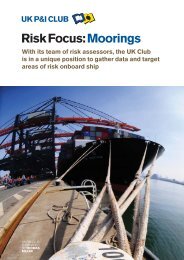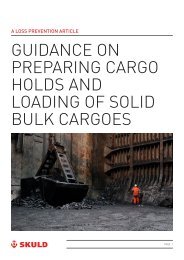Create successful ePaper yourself
Turn your PDF publications into a flip-book with our unique Google optimized e-Paper software.
<strong>ECSA</strong><br />
<strong>The</strong> <strong>Tramp</strong> <strong>Shipping</strong> <strong><strong>Mar</strong>ket</strong><br />
iron ore imports. In such cases, the contract is generally placed before the vessel is<br />
actually built. Shorter-term time charters for twelve months or three to five years<br />
would be obtained on the charter market.<br />
3. Voyage and trip charter (Spot Charter): shippers e and traders with cargo can<br />
contract for freight on the spot market, often using a shipbroker to act on their behalf<br />
and negotiate a rate. A “voyage charter” is a contract to deliver the cargo for a<br />
negotiated price per tonne, whilst a “trip charter” hires the ship for a voyage, leaving<br />
the shipper to deal with the details and expense of loading and discharging cargo. . For<br />
example in agricultural trades such as grain and sugar seasonal factors and the<br />
volatility of the market make it difficult to plan shipping requirements in advance. Or<br />
the cargo could be a consignment of prefabricated buildings for the Middle East or<br />
some heavy plant. In such cases, bulk or multi-deck tonnage is chartered for a single<br />
voyage via some market such as the Baltic Exchange or broker network, where the<br />
shipper can hire a shipon a voyage or trip basis. A trip charter hires the vessel on a<br />
per day basis for the period of a specific voyage and for the carriage of a specific<br />
cargo. <strong>The</strong> shipowner earns “hire” per day for the period determined by the voyage.<br />
4. Contract of Affreightment: the shipper may, normally through an open tendering<br />
procedure, enter into a long-term arrangement with a shipowner who specializes in a<br />
particular area of bulk shipping, supported by suitable tonnage. For example,<br />
Scandinavian shipowners are involved in the carriage of forest products from West<br />
Coast North America to Europe and run fleets of specialist ships designed to optimize<br />
the bulk transportation of forest products. Similarly, the transportation of motor cars is<br />
serviced by companies, which run fleets of pure vehicle carriers and Ro Ros servicing<br />
the Japanese car export trade. COAs are also used in other trades such as coal,<br />
fertilizer, grain, ore and oil.<br />
7. <strong>The</strong> companies involved in the shipping business<br />
7.1 <strong>Shipping</strong> Companies and support services<br />
<strong>The</strong>re are five categories 10 of company involved in the transport chain, two directly and three<br />
indirectly. <strong>The</strong> relevant companies are<br />
1. Cargo owners<br />
2. Traders<br />
3. Shipowners (shipping companies/operators),<br />
4. Ship managers<br />
5. Ship brokers<br />
Each has a different perspective on the business.<br />
An important group of the past twenty years, cargo owners have cargo to be moved by sea. <strong>The</strong>y<br />
may be primary producers such as oil companies or iron ore mines. Or they may be manufacturers<br />
or wholesalers importing raw materials or equipment. A third important group in last 20 years has<br />
been traders who purchase commodities on a speculative basis with a view to reselling them,<br />
often in a different location, so they become involved in the transport process. Some cargo<br />
owners have a very short term approach to the business, and just want to purchase transport when<br />
they need it. Others take a more long term perspective, and may become deeply involved in the<br />
10 Some companies will combine two or more of the listed functions.<br />
Clarkson Research Services Limited 23 <strong>Mar</strong>ch <strong>2015</strong>




